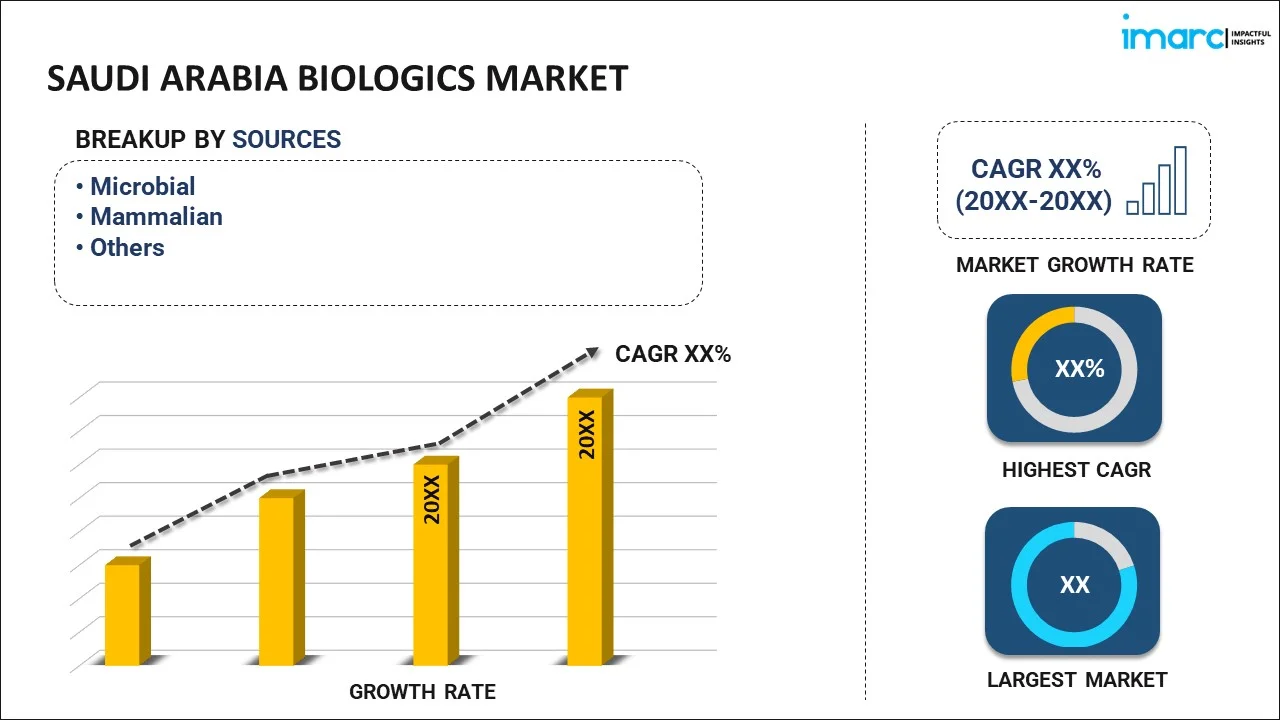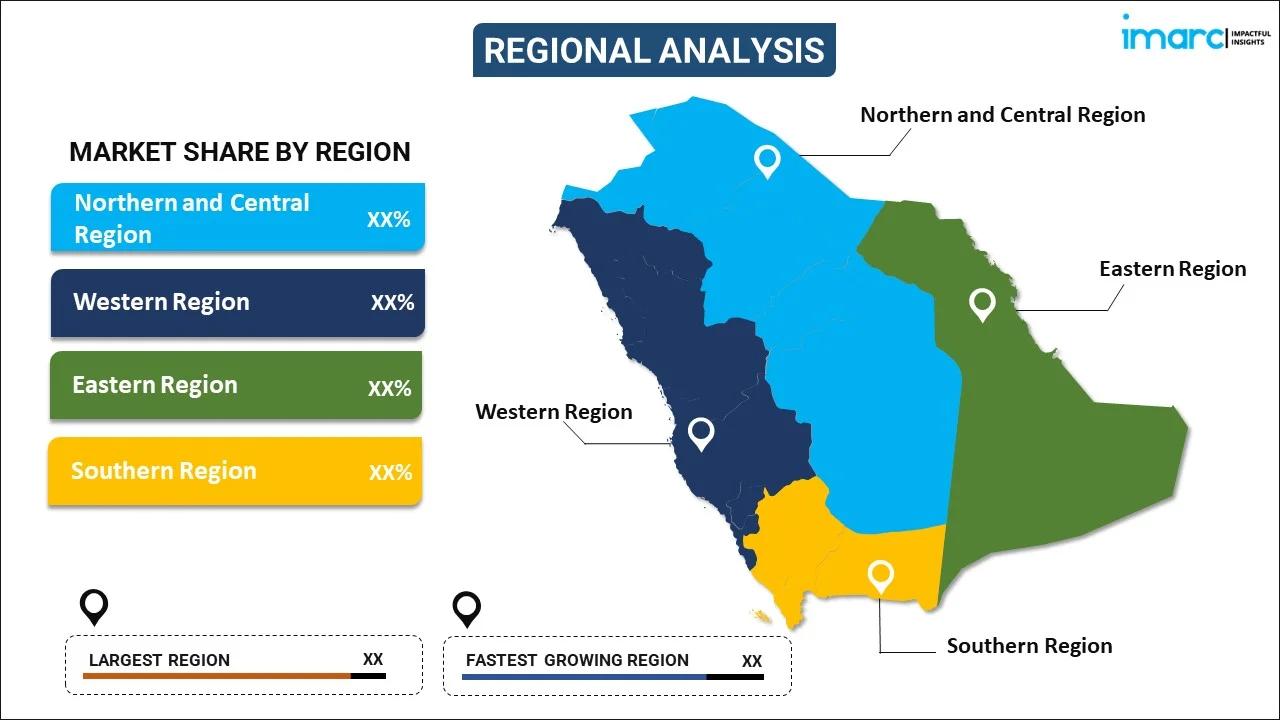
Saudi Arabia Biologics Market Report by Source (Microbial, Mammalian, and Others), Product (Monoclonal Antibodies, Vaccines, Recombinant Proteins, Antisense, RNAi and Molecular Therapy, and Others), Disease (Oncology, Immunological Disorders, Cardiovascular Disorders, Hematological Disorders, and Others), Manufacturing (Outsourced, In-House), and Region 2024-2032
Market Overview:
Saudi Arabia biologics market size is projected to exhibit a growth rate (CAGR) of 6.86% during 2024-2032. The increasing demand for advanced therapeutic solutions, the rising awareness and acceptance of biologic therapies among healthcare professionals and patients, and the government's commitment to healthcare sector development represent some of the key factors driving the market.
|
Report Attribute
|
Key Statistics
|
|---|---|
|
Base Year
|
2023 |
|
Forecast Years
|
2024-2032
|
|
Historical Years
|
2018-2023
|
| Market Growth Rate (2024-2032) | 6.86% |
Biologics, also known as biopharmaceuticals, are medicinal products derived from living organisms, including humans, animals, microorganisms, or yeast. They represent a sophisticated and innovative class of therapeutic solutions, contrasting markedly from traditional chemically synthesized drugs. They encompass a broad range of product types, such as vaccines, blood components, gene therapies, tissues, and recombinant therapeutic proteins. These products are characterized by their complex molecular structures and intricate manufacturing processes. The uniqueness of biologics lies in their ability to target specific components of the body with precision, offering enhanced treatment efficacy and fewer side effects compared to conventional medications. This precision stems from the biological nature of their sources, which allows them to interact with the body's natural biological processes effectively. The advantages of biologics include their potential to treat a wide array of chronic diseases, including various types of cancers, rheumatoid arthritis, and autoimmune disorders, that were previously difficult to manage with standard drug therapies. Their ability to offer personalized treatment solutions tailored to individual patient needs further underscores their growing significance in modern healthcare.
Saudi Arabia Biologics Market Trends:
The biologics market in Saudi Arabia is propelled by the increasing prevalence of chronic diseases such as diabetes, cancer, and autoimmune disorders in the region. This can be supported by the escalating demand for advanced therapeutic solutions. Additionally, the Saudi government's commitment to healthcare sector development, evidenced through substantial investments and initiatives, is positively influencing the market. This vision aims to diversify the economy and includes strategies to develop domestic pharmaceutical manufacturing capabilities, particularly in biologics. Therefore, this is positively influencing the market. Along with this, the growing awareness and acceptance of biologic therapies among healthcare professionals and patients in Saudi Arabia is significantly supporting the market. In addition, the country is witnessing an increase in partnerships and collaborations between local and international biopharmaceutical companies aimed at enhancing research and development activities in biologics. These collaborations are pivotal in bringing cutting-edge biologic therapies to the Saudi market, fostering innovation and technological advancements in the sector. Moreover, the regulatory environment in Saudi Arabia is also evolving to support faster approval and enhanced market access for biologic drugs, further stimulating market growth. Apart from this, the rising healthcare expenditure and the government's focus on improving healthcare infrastructure are contributing to the market. Furthermore, the continuous innovations in pharmaceutical manufacturing are creating a positive market outlook. Some of the other factors driving the market include rapid urbanization and changing consumer preferences.
Saudi Arabia Biologics Market Segmentation:
IMARC Group provides an analysis of the key trends in each segment of the market, along with forecasts at the country level for 2024-2032. Our report has categorized the market based on source, product, disease, and manufacturing.
Source Insights:

- Microbial
- Mammalian
- Others
The report has provided a detailed breakup and analysis of the market based on the source. This includes microbial, mammalian, and others.
Product Insights:
- Monoclonal Antibodies
- Vaccines
- Recombinant Proteins
- Antisense, RNAi and Molecular Therapy
- Others
A detailed breakup and analysis of the market based on the product have also been provided in the report. This includes monoclonal antibodies, vaccines, recombinant proteins, antisense, RNAi and molecular therapy, and others.
Disease Insights:
- Oncology
- Immunological Disorders
- Cardiovascular Disorders
- Hematological Disorders
- Others
The report has provided a detailed breakup and analysis of the market based on the disease. This includes oncology, immunological disorders, cardiovascular disorders, hematological disorders, and others.
Manufacturing Insights:
- Outsourced
- In-House
A detailed breakup and analysis of the market based on the manufacturing have also been provided in the report. This includes outsourced and in-house.
Regional Insights:

- Northern and Central Region
- Western Region
- Eastern Region
- Southern Region
The report has also provided a comprehensive analysis of all the major regional markets, which include Northern and Central Region, Western Region, Eastern Region, and Southern Region.
Competitive Landscape:
The market research report has also provided a comprehensive analysis of the competitive landscape. Competitive analysis such as market structure, key player positioning, top winning strategies, competitive dashboard, and company evaluation quadrant has been covered in the report. Also, detailed profiles of all major companies have been provided.
Saudi Arabia Biologics Market Report Coverage:
| Report Features | Details |
|---|---|
| Base Year of the Analysis | 2023 |
| Historical Period | 2018-2023 |
| Forecast Period | 2024-2032 |
| Units | US$ Million |
| Scope of the Report | Exploration of Historical and Forecast Trends, Industry Catalysts and Challenges, Segment-Wise Historical and Predictive Market Assessment:
|
| Sources Covered | Microbial, Mammalian, Others |
| Products Covered | Monoclonal Antibodies, Vaccines, Recombinant Proteins, Antisense, RNAi and Molecular Therapy, Others |
| Diseases Covered | Oncology, Immunological Disorders, Cardiovascular Disorders, Hematological Disorders, Others |
| Manufacturings Covered | Outsourced, In-House |
| Regions Covered | Northern and Central Region, Western Region, Eastern Region, Southern Region |
| Customization Scope | 10% Free Customization |
| Report Price and Purchase Option | Single User License: US$ 3699 Five User License: US$ 4699 Corporate License: US$ 5699 |
| Post-Sale Analyst Support | 10-12 Weeks |
| Delivery Format | PDF and Excel through Email (We can also provide the editable version of the report in PPT/Word format on special request) |
Key Questions Answered in This Report:
- How has the Saudi Arabia biologics market performed so far and how will it perform in the coming years?
- What has been the impact of COVID-19 on the Saudi Arabia biologics market?
- What is the breakup of the Saudi Arabia biologics market on the basis of source?
- What is the breakup of the Saudi Arabia biologics market on the basis of product?
- What is the breakup of the Saudi Arabia biologics market on the basis of disease?
- What is the breakup of the Saudi Arabia biologics market on the basis of manufacturing?
- What are the various stages in the value chain of the Saudi Arabia biologics market?
- What are the key driving factors and challenges in the Saudi Arabia biologics?
- What is the structure of the Saudi Arabia biologics market and who are the key players?
- What is the degree of competition in the Saudi Arabia biologics market?
Key Benefits for Stakeholders:
- IMARC’s industry report offers a comprehensive quantitative analysis of various market segments, historical and current market trends, market forecasts, and dynamics of the Saudi Arabia biologics market from 2018-2032.
- The research report provides the latest information on the market drivers, challenges, and opportunities in the Saudi Arabia biologics market.
- Porter's five forces analysis assist stakeholders in assessing the impact of new entrants, competitive rivalry, supplier power, buyer power, and the threat of substitution. It helps stakeholders to analyze the level of competition within the Saudi Arabia biologics industry and its attractiveness.
- Competitive landscape allows stakeholders to understand their competitive environment and provides an insight into the current positions of key players in the market.
Need more help?
- Speak to our experienced analysts for insights on the current market scenarios.
- Include additional segments and countries to customize the report as per your requirement.
- Gain an unparalleled competitive advantage in your domain by understanding how to utilize the report and positively impacting your operations and revenue.
- For further assistance, please connect with our analysts.
 Inquire Before Buying
Inquire Before Buying
 Speak to an Analyst
Speak to an Analyst
 Request Brochure
Request Brochure
 Request Customization
Request Customization




.webp)




.webp)












